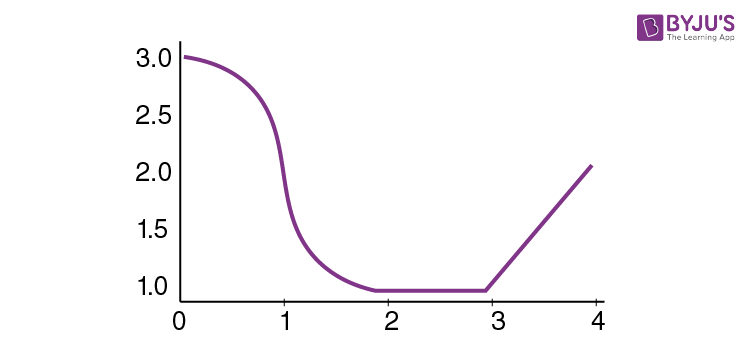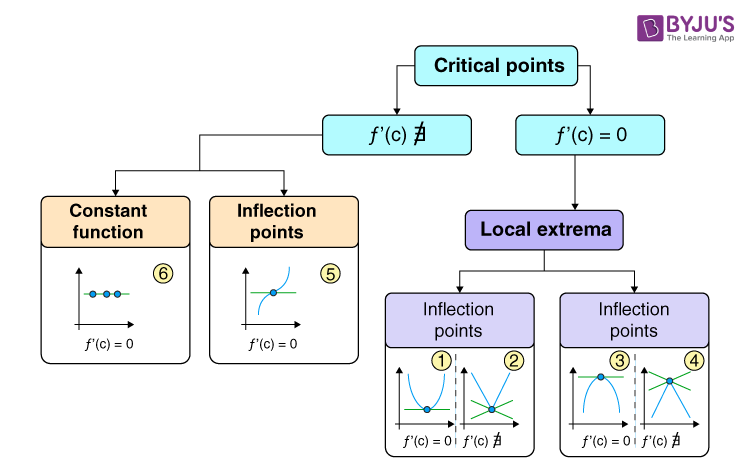A point c in the domain of a function f(x) is called a critical point of f(x), if f ‘(c) = 0 or f ‘(c) does not exist. This article explains the critical points along with solved examples.
A function f, which is continuous with x in its domain, contains a critical point at point x if the following conditions hold good.
- f ’(x) = 0
- f ’(x) is undefined.
A point of a differentiable function f at which the derivative is zero can be termed a critical point.
The types of critical points are as follows:
- A critical point is a local maximum if the function changes from increasing to decreasing at that point, whereas it is called a local minimum if the function changes from decreasing to increasing at that point.
- A critical point is an inflexion point if the concavity of the function changes at that point.
- If a critical point is neither of the above, then it signifies a vertical tangent in the graph of a function.

This function has critical points at x = 1 and x = 3.
Classification of critical points is explained below:

Also, Read:
Solved Problems on Critical Points
Example 1: Find the critical points of the function f (x) = x2 lnx.
Solution:
Take the derivative using the product rule:
f ′ (x) = (x2 lnx)′ = 2x * ln x + x2 * [1 / x] = 2x ln x + x = x (2 ln x + 1).
Determine the points where the derivative is zero:
f′(c) = 0, ⇒ c (2 ln c + 1) = 0.
The first root, c1 = 0, is not a critical point because the function is defined only for x > 0.
Consider the second root:
2 ln c + 1 = 0, ⇒ ln c =−1 / 2,
⇒ c2 = e −1/2 = 1 / √e.
Hence, c2 = 1 / √e is a critical point of the given function.
Example 2: Local maximum and local minimum values of the function (x − 1) (x + 2)2 are _______.
Solution:
f′(x) = 2 (x − 1) (x + 2) + (x + 2)2 = 3x2 + 6x
f′(x) = 0
x = 0, −2
f (−2) = (−2 −1) (−2 + 2)2 = 0 (Maximum value), and
f (0) = (0 − 1) (0 + 2)2 = −4 (Minimum value).
Example 3: Whether the given function x * √[1 − x2], (x > 0) has local maxima or minima?
Solution:
Let f (x) = x * √[1 − x2]
f′(x) = [1 − 2x2] / √[1 − x2] = 0
⇒ x = ± 1 / √2
But as x > 0, we have x = 1 / √2
Now, again f′′(x) = {(√[1 − x2] (−4x)) − ((1 − 2x2) * (− x / √[1 − x2])} / [1 − x2] = [2x3 − 3x] / (1 − x2)3/2
⇒ f′′(1 / √2) = −ve.
Then, f (x) is maximum at x = 1 / √2.
Example 4: The area of a rectangle will be the maximum for the given perimeter when a rectangle is a ________.
Solution:
We know that the perimeter of a rectangle, S = 2 (x + y), where x and y are adjacent sides.
y = [S − 2x] / 2.
Now, the area of a rectangle,
A = xy = [x / 2] * (S − 2x) = [1 / 2] * (Sx − 2x2)
Differentiating w.r.t. x of A, we get
dA / dx = 1 / 2 (S − 4x) = 0
∴ x = S / 4 and y = S / 4
Again d2A / dx2 = −ve
Hence, the area of the rectangle will be maximum when the rectangle is a square.
Example 5: If f (x) = 2x3 − 3x2 − 12x + 5 and x ∈ [−2, 4], then the maximum value of the function is at what value of x?
Solution:
f′(x) = 6x2 − 6x − 12
f′(x) = 0
⇒ (x − 2) (x + 1) = 0
⇒ x = −1, 2
Here, f (4) = 128 − 48 − 48 + 5 = 37
f (−1) = −2 − 3 + 12 + 5 = 12
f (2) = 16 − 12 − 24 + 5 = −15
f (−2) = −16 − 12 + 24 + 5 = 1
Therefore, the maximum value of the function is 37 at x = 4.
Example 6: The function sin x (1 + cos x) at x = π / 3 is ____________.
Solution:
Let f (x) = sin x (1 + cos x)
f′(x) = cos 2x + cos x and f′′(x) =−2 sin 2x − sin x = −(2 sin 2x + sin x)
For maximum or minimum value of f (x), f′(x) = 0
cos 2x + cos x = 0
cos x = −cos 2x
cos x = cos (π ± 2x)
∴ x = π ± 2x or x = π / 3, −π
Now, f′′(π / 3) = −2sin 2π / 3 − sin π / 3 = [−2] * [(√3) / 2] − √3 / 2 = −3√3 / 2 =−ve
Hence, f (x)is maximum at x = π / 3.
Example 7: If x + y = 10, then the maximum value of xy is __________.
Solution:
x + y =10
∴ y = 10 − x ……..(i)
Now f (x) = xy = x (10 − x) = 10x − x2
∴ f′(x) = 10 − 2x
For maximum value of f (x), f′ (x) = 0
∴ x = 5 and y = 5
So, the maximum value of xy = 5 × 5 = 25.
Example 8: The point (0, 5) is closest to the curve x2 = 2y, is ________.
Solution:
Let a point on the curve by (h, k).
Then, h2 = 2k…..(i)
Distance = D
By (i);
So, at k = 4, function D must be minimum.
Then, the point will be (±2√2, 4).
Example 9:
A) 11
B) 12
C) 10
D) 14
Solution:
Let
Put
Again,
Now,
Hence, the minimum value = 12.
Example 10: The function f(x) = x-x, x ∈ R attains a maximum value at x = _____.
A) 2
B) 3
C) 1/e
D) 1
Solution:
Differentiating w.r.t. x,
Put dy/dx = 0
Example 11: If y = a log x + bx2 + x has its extremum value at x = 1 and x = 2, then (a, b) = ______.
Solution:
Example 12: If
Solution:
Put f'(x) = 0
8x + 2 = 0
x = -1/4
Comments